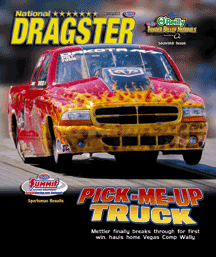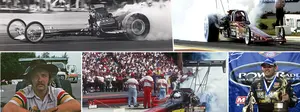

Getting off to a good start
Like any good drag racing, a good story of any kind requires a good start. It doesn’t always have to be a quick start, but it had better be good because if it isn’t, the driver or reader might not make it to the finish. There, did I get your attention?
A writer who begins a story like a blubbering engine that’s misfiring on all cylinders is probably going to lose his or her readers not long after, so one of the first things you learn as a writer is to craft a creative and catchy lead paragraph. It’s understood that people generally will read the headline and subheadlines and scan the photos and captions to decide if they even want to start to read a story, but that you can even lose them shortly after they’ve entered the story if you confuse or bore them (kind of like what I’m on the verge of doing with that long explanation).
The writer’s decision of what the lead should be is one of the biggest factors in making a story inviting, yet sometimes it’s the last thing you decide upon. You can write the guts of the story, which often contains factual information, quotes, and the like that might help you decide what lead best sums up the story or leads into that information.
In my pre-ND days, I started writing professionally for car magazines, freelancing for various custom-car magazines such as Custom Rodder and Truckin’. My best friend, C. Van Tune, and I both knew we wanted to write for car magazines, but he landed a job first in a career that eventually led him to the pinnacle of car-guy journalism, as editor of Motor Trend, and it was through him I got my first official writing assignment and my first warning: The editor, Bruce Hampson, liked really catchy leads, and if you didn’t have one, he would probably reject the piece rather than write one of his own. The first stories were almost exclusively car features, where I was handed a tech sheet and precious little background on which to base a story. I learned to be creative.
That skill helped immensely when I began work at National DRAGSTER because back in 1982 – raise your hand if you were with us back then; hmmm, not many – we ran ALL of the national event coverage in the first issue, which could mean that the three writers tackled as many as three stories each in a day. The Pro stories were easier because one of us usually had been at the event – but not always; our travel was severely limited back then – but the Sportsman stories were, by nature, cookie-cutter round-by-round narratives with no opportunity to interview the winner as we do now.
The one-day rain delay in the completion of Sportsman racing at the 1986 Winternationals changed all that, forcing us to push their race reports into the next issue, but it also gave us time to interview the drivers. Later that year, we adopted the format we now have with a Pro and a Sportsman results issue.
It’s always a pleasure talking to the Sportsman winners, because even the winningest among them retain an air of awe at their accomplishments. They’re also very grateful that National DRAGSTER spotlights them as only we do, with each winner receiving a two-page spread and an in-depth interview where they can not only share with us what the win meant to them, but also spread the thanks around to their sponsors and team. Not many magazines reward them the space we do, and it’s something that I don’t ever see changing. I’ve written hundreds of these Sportsman stories in my years here at ND, and I still look forward to them.
Sometimes you go into an interview with a preconceived lead based on what you know -– after, say, interviewing David Rampy about 50 times -- and sometimes it sticks; sometimes you get a whole other angle. But somehow, the lead almost always arrives, sometimes like a bolt out of the blue if you just keep chitchatting long enough.
 |
Here’s a good example. I was interviewing Sonoma Comp winner Tom Mettler the other day. Tom’s a great guy, very personable, full of good quotes, and we had a history because I had interviewed him after his first win, which was at last year’s spring Las Vegas event. Plus I was his best buddy for putting his truck on the cover (pictured).
Anyway, there was nothing particularly special about the way he won, and as the conversation went on, in the back of my mind the best thing I had going for a lead was the fact that he hadn’t been in his race car since the Chicago race in June. As we’re talking, my mind is going through the gears -- ”Okay, maybe something about him obviously not losing his touch.” -- then he told me that his whole family was there to see him win, unlike in Vegas, where it had just been his father. “Okay,” my mind says, “maybe the angle is that he obviously was waiting to play to a better audience,” kind of like how Barry Bonds wants to hit his asterisked 756th dinger in San Fran instead of San Diego. It’s not that great an angle, but, hey, it’s an angle.
As we’re wrapping up the conversation, he tells me about this new little farm he bought as a second income and I ask again what he does for a living. Turns out he installs and repairs huge water pumps that help irrigate the farms in the Bakersfield area. “We’ve got quite a drought going on,” he says. A little light went off in my head, and a lead was born.
When he’s not tearing up the quarter-mile in his PST Dakota, Tom Mettler works weekdays as a Cummings dealer specializing in the sales, service, and installation of gasoline-powered water pumps that help irrigate farms in areas surrounding his Bakersfield, Calif., home. His father Don and uncle Ron farm alfalfa and pistachios and other crops, and Mettler himself just bought a small alfalfa farm outside of Wasco, so he knows that water is the lifeblood of the region, especially in the midst of a near-drought this year in the Golden State.
While Mettler may have found heaven-borne water in short supply, there’s been no drought for the Dodge driver when it comes to victories as he followed up last year’s win in Las Vegas – his first national event triumph in five years of racing – with a big Lucas Oil Series win earlier this year in Tucson, Ariz., and added a huge victory in Sonoma at the Fram Autolite NHRA Nationals.
See how easy that was?



















































